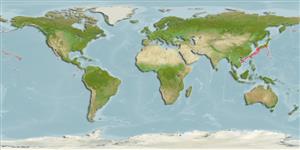Elasmobranchii (haaien en roggen) (sharks and rays) >
Squaliformes (Sleeper and dogfish sharks) >
Etmopteridae (Lantern sharks)
Etymology: Trigonognathus: Greek, trigono = a triangle + Greek, gnathos = jaw (Ref. 45335). Refers to the triangular shape of the jaws (Ref. 31259); kabeyai: Named after Mr. Hiromichi Kabeya who collected the type specimens (Ref. 31259).
Environment: milieu / climate zone / depth range / distribution range
Ecologie
marien bathydemersaal; diepte 330 - 360 m (Ref. 31259). Deep-water
Northwest Pacific: Wakayama and Tokushima, Japan (Ref. 31259). Reported from the Hawaiian Islands (Ref. 58302).
Lengte bij maturiteit / Grootte / Gewicht / Leeftijd
Maturity: Lm 52.0 range ? - ? cm
Max length : 47.0 cm TL mannelijk / geslacht onbekend; (Ref. 55729); 53.9 cm TL (female); max. gepubliceerd gewicht: 425.60 g (Ref. 55729); max. gepubliceerd gewicht: 425.60 g
Specimens collected between 330 and 360 m (Ref. 31259). Ovoviviparous (Ref. 205).
Levenscyclus en paargedrag
Maturiteit | Voortplanting | Paaien | Eieren | Fecunditeit | Larven
Distinct pairing with embrace (Ref. 205).
Mochizuki, K. and F. Ohe, 1990. Trigonognathus kabeyai, a new genus and species of the squalid sharks from Japan. Jap. J. Ichthyol. 36(4):385-390. (Ref. 31259)
Status op de Rode Lijst van het IUCN (Ref. 130435)
Gevaar voor de mens
Harmless
Gebruik door de mens
Meer informatie
Leeftijd/GrootteGroeiLengte-gewichtLengte-lengteLengtefrequentiesMorfometrieMorfologieLarvenLarvale populatiedynamiekRekruteringAbundantieBRUVS
ReferentiesAquacultuurAquacultuurprofielKweeklijnenGeneticaElectrophoresesErfelijkheidZiektesVerwerkingNutrientsMassaconversie
Tools
Speciale rapporten
Download XML
Internetbronnen
Estimates based on models
Preferred temperature (Ref.
123201): 10.4 - 16.3, mean 11.4 °C (based on 5 cells).
Fylogenetische diversiteitsindex (Ref.
82804): PD
50 = 1.0000 [Uniqueness, from 0.5 = low to 2.0 = high].
Bayesian length-weight: a=0.00372 (0.00188 - 0.00734), b=3.10 (2.92 - 3.28), in cm total length, based on LWR estimates for this (Sub)family-body shape (Ref.
93245).
Trofisch niveau (Ref.
69278): 4.5 ±0.4 se; based on diet studies.
Weerstandsvermogen (Ref.
120179): laag, minimale populatieverdubbelingstijd 4,5-14 jaar (Fec assumed to be <100).
Fishing Vulnerability (Ref.
59153): Moderate vulnerability (42 of 100).
